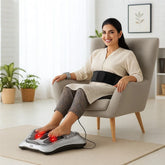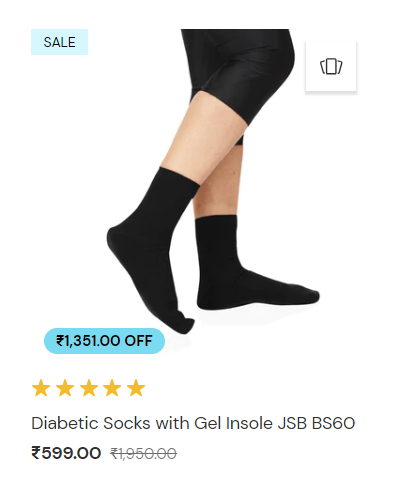Do diabetic socks really work?
Introduction :
For those living with diabetes, managing foot health is not just a matter of comfort; it's a critical aspect of overall well-being. Among the many tools in the arsenal for diabetic foot care, one often hears about "diabetic socks." But do these specialized socks truly live up to their promises of improved comfort and reduced risk of complications? With conflicting opinions circulating, it's essential to delve deeper into the science and practicality behind diabetic socks to separate fact from fiction.
In this comprehensive exploration, we'll navigate through the intricacies of diabetic socks, addressing common questions and concerns. From understanding the unique needs of diabetic feet to evaluating the efficacy of various sock features, we'll embark on a journey to uncover the truth about diabetic socks. Whether you're a diabetic individual seeking the best foot care options or a caregiver aiming to enhance your loved one's comfort and health, this blog post aims to provide clarity and guidance in making informed decisions.
Join us as we unravel the mysteries surrounding diabetic socks, separating hype from reality and empowering you with the knowledge needed to prioritize foot health effectively in the diabetic journey.
Do diabetic socks really work?
The question of whether diabetic socks truly work is one that resonates deeply with many individuals managing diabetes. Diabetic socks are specifically designed to address the unique needs and challenges associated with diabetic feet, which can be prone to complications such as neuropathy, poor circulation, and increased susceptibility to infection. These specialized socks often boast features such as seamless construction, extra cushioning, moisture-wicking properties, and non-binding tops, all aimed at providing comfort and reducing the risk of foot problems.
But do they deliver on their promises?
Research and anecdotal evidence suggest that diabetic socks can indeed make a difference in foot health for many individuals. Here's how they may work:
-
Moisture Management: Diabetic socks typically feature materials that help wick moisture away from the skin, reducing the likelihood of fungal infections and skin breakdown.
-
Reduced Friction: Seamless construction and soft, non-binding materials can minimize friction and pressure points, lowering the risk of blisters, calluses, and ulcers.
-
Improved Circulation: Some diabetic socks are designed with mild compression to promote better blood flow, which can be beneficial for individuals with circulation issues.
-
Enhanced Comfort: The extra padding and cushioning in diabetic socks can provide added comfort, particularly for those who spend long hours on their feet.
-
Prevention of Complications: By minimizing the risk of foot injuries and infections, diabetic socks may help prevent more serious complications, such as diabetic foot ulcers and amputations.
However, it's essential to recognize that the effectiveness of diabetic socks can vary from person to person. While many individuals report significant benefits from wearing diabetic socks, others may not experience the same level of improvement. Additionally, diabetic socks are just one component of a comprehensive foot care regimen for diabetes, which should also include regular foot inspections, proper footwear, and proactive management of blood sugar levels.
Ultimately, whether diabetic socks "work" depends on individual factors such as foot anatomy, existing health conditions, and lifestyle habits. It's crucial for individuals with diabetes to work closely with their healthcare providers to determine the most appropriate foot care strategies, which may or may not include the use of diabetic socks. By staying informed and proactive, individuals can take meaningful steps towards preserving their foot health and overall well-being.
What type of socks are best for diabetics?
Choosing the best socks for individuals with diabetes involves considering several key factors to promote foot health and comfort. While preferences may vary depending on individual needs and preferences, here are some features to look for in diabetic socks:
-
Seamless Design: Socks with seamless construction help prevent rubbing and friction against the skin, reducing the risk of blisters, sores, and irritation.
-
Non-Binding Tops: Diabetic socks should have non-binding tops that do not constrict circulation or leave marks on the legs. This feature helps prevent constriction and promotes healthy blood flow to the feet.
-
Moisture-Wicking Material: Look for socks made from moisture-wicking fabrics such as merino wool or synthetic blends. These materials help keep feet dry by drawing moisture away from the skin, reducing the risk of fungal infections and skin breakdown.
-
Extra Padding and Cushioning: Socks with extra padding and cushioning provide additional comfort and protection, especially for individuals with sensitive or neuropathic feet. Cushioned soles can help absorb impact and reduce pressure points.
-
Antimicrobial Properties: Some diabetic socks are treated with antimicrobial agents to inhibit the growth of bacteria and fungi, further reducing the risk of infections.
-
Proper Fit: Diabetic socks should fit snugly without being too tight or too loose. Avoid socks that are too constricting, as they can impair circulation, or too loose, as they may bunch up and cause friction.
-
Compression Features (Optional): For individuals with circulation issues, diabetic socks with mild compression can help promote blood flow and reduce swelling. However, it's essential to consult with a healthcare professional before using compression socks, as they may not be suitable for everyone.
When selecting diabetic socks, it's essential to prioritize comfort, fit, and functionality. Additionally, individuals with diabetes should inspect their feet regularly for any signs of irritation, blisters, or injuries, and seek prompt medical attention if any issues arise. By wearing appropriate socks and practicing good foot care habits, individuals with diabetes can help maintain healthy feet and reduce the risk of complications.
What is the difference between diabetic socks and regular socks?
The difference between diabetic socks and regular socks lies primarily in their design and intended purpose. While both types of socks serve the basic function of providing comfort and protection for the feet, diabetic socks are specifically tailored to address the unique needs and challenges associated with diabetes-related foot conditions. Here are some key distinctions between diabetic socks and regular socks:
-
Seamless Construction: Diabetic socks typically feature seamless designs to minimize friction and reduce the risk of rubbing against the skin. This helps prevent blisters, ulcers, and other skin irritations, which can be particularly problematic for individuals with diabetes due to reduced sensation (neuropathy).
-
Non-Binding Tops: Diabetic socks have non-binding or loose-fitting tops that don't constrict circulation. This feature helps prevent pressure points and ensures optimal blood flow to the feet, reducing the risk of foot complications such as edema (swelling) and impaired circulation.
-
Extra Padding and Cushioning: Many diabetic socks are equipped with additional padding and cushioning in key areas, such as the heels and balls of the feet. This provides added comfort and protection, especially for individuals who spend long periods on their feet or have a tendency to develop calluses or ulcers.
-
Moisture-Wicking Properties: Diabetic socks often incorporate moisture-wicking materials that help keep the feet dry and reduce the risk of fungal infections and skin breakdown. Proper moisture management is crucial for maintaining healthy skin integrity, particularly for individuals with diabetes who may be more susceptible to foot infections.
-
Antimicrobial Treatment: Some diabetic socks are treated with antimicrobial agents to inhibit the growth of odor-causing bacteria and fungi. This helps maintain foot hygiene and reduce the risk of foot infections, which can be more challenging to treat in individuals with diabetes.
-
Fit and Sizing Options: Diabetic socks are available in a range of sizes and fits to accommodate various foot shapes and conditions. They are often designed with stretchy, non-constricting materials that provide a comfortable yet secure fit without causing pressure points or constriction.
Overall, diabetic socks are engineered with the specific needs of diabetic individuals in mind, prioritizing comfort, protection, and foot health. While regular socks may suffice for some individuals, those with diabetes or at risk of diabetes-related foot complications may benefit from the specialized features offered by diabetic socks to help maintain optimal foot health and reduce the risk of complications.
Conclusion on Do diabetic socks really work :
In conclusion, the question of whether diabetic socks really work is one that requires careful consideration of individual needs, preferences, and circumstances. While diabetic socks are specifically designed to address the unique challenges associated with diabetes-related foot conditions, their effectiveness can vary from person to person.
For many individuals with diabetes, diabetic socks can provide significant benefits such as reduced friction, improved comfort, enhanced moisture management, and better circulation. These specialized socks may help prevent common foot problems such as blisters, calluses, ulcers, and infections, ultimately contributing to better foot health and overall well-being.
However, it's important to recognize that diabetic socks are just one component of a comprehensive foot care regimen for diabetes. Proper foot care also involves regular foot inspections, appropriate footwear, diligent blood sugar management, and collaboration with healthcare professionals.
Ultimately, whether diabetic socks "work" depends on various factors, including individual foot anatomy, existing health conditions, lifestyle factors, and adherence to proper foot care practices. While diabetic socks can be a valuable tool in managing foot health for many individuals with diabetes, it's essential to consult with healthcare providers to determine the most suitable foot care strategies for individual needs.
By staying informed, proactive, and engaged in their foot care, individuals with diabetes can empower themselves to make informed decisions and take proactive steps towards preserving their foot health and overall quality of life.











